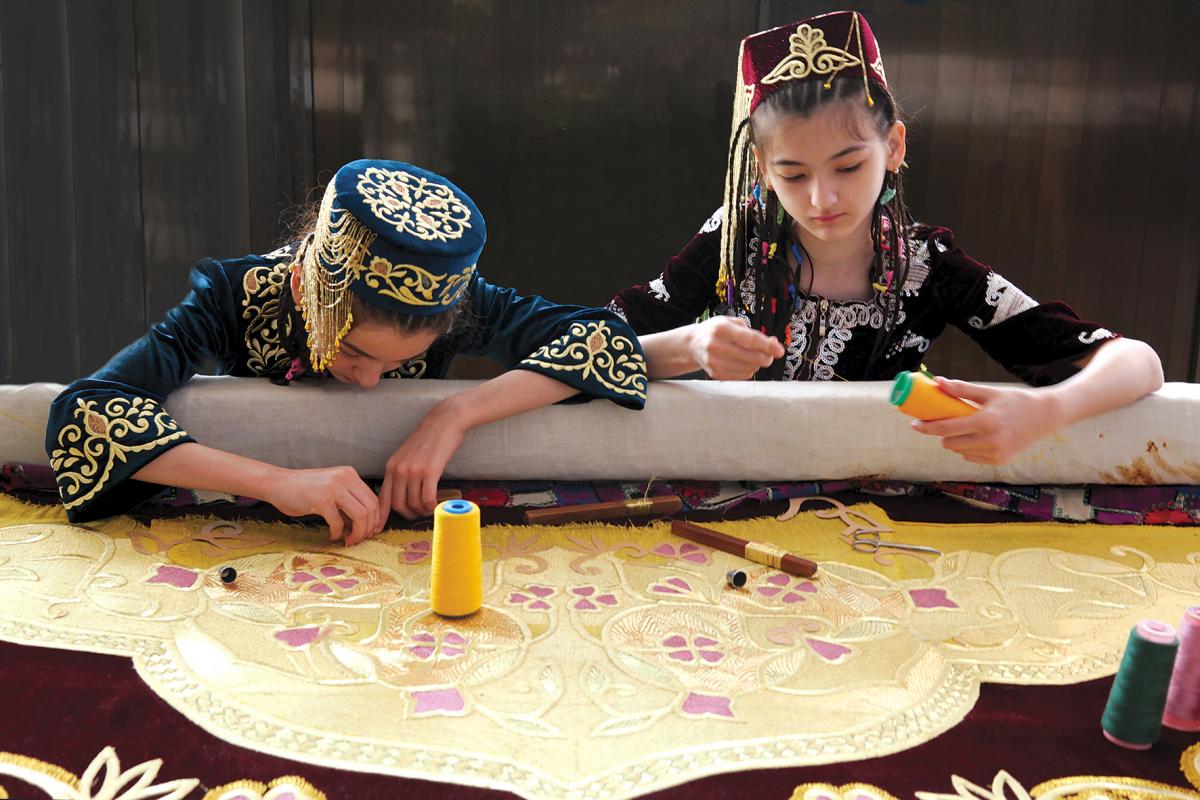Refinement and Magnificence of Asian Splendour
Since ancient times in a number of nations, including the nations of Central Asia, gold has been a symbol of light and immortality. Silver was connected with ancient magic and was considered as purifying substance depriving poisons of their evil force; it was also considered that the sound of ringing silver expels evil spirits.

Zarduzi, the art of making embroidery with gold thread has existed in the territory of Uzbekistan since very ancient times. The well-known paintings in the palaces of Balalyktepa, Varakhsha and Afrasiab (6th-8th centuries) are clear evidence of this, depicting people dressed in clothes decorated with goldwork.
Ruy Gonzalez de Clavijo, the Spanish ambassador to Tamerlane's court in 1403-1406, wrote in his diary that the ruler’s wife Saray-Mulk-Khanum wore dresses embroidered with gold thread.
The ancient traditions of goldwork survived to the late 19th century. Bukharian artisans created an original style, which had no analogies in technique, composition or ornamentation.
‘History of Bukhara’ written by 10th-century historian Narshakhi is the first scientific work that mentioned the Bukhara goldwork. Unfortunately, ancient samples of embroidery have not survived to our days. We can judge about it only by museum exhibits belonging to the 19th century.
Ceremonial clothes, headdresses and shoes were decorated with gold embroidery. It is curious that only men were engaged in the craft of goldwork. The knowledge was passed from father to son.
In the 20th century the art of gold embroidery spread beyond the borders of the Emirate of Bukhara. At that time the production of goldwork items also began in Samarkand, Urgut, Tashkent, Gijduvan, and other cities and towns. Gold embroidery became highly popular worldwide due to its refined patterns, complex technique and fantastic images. Nowadays usually women work in this craft. As it was many years ago, they stitch items manually, making them lush and rich in their own way. A skullcap or suzani, shoes or a robe – each thing is a real work of art.
Beautiful samples of clothes and other domestic items decorated with gold embroidery can be found among exhibits in a number of state museums of Uzbekistan, such as the State Museum of History, State Museum of Arts, Museum of Applied Arts, State Museum of the Timurid History and others. The Bukhara State Museum of Art and Architecture also has a rich collection of items decorated with goldwork.
Ceremonial robes from Bukhara embroidered with gold, zarchopon, strike one’s imagination with their decorative and ornamental diversity: there is not a pair of identical robes. In former times emirs and court aristocracy wore such robes. There were also ceremonial robes which were among items presented to ambassadors or royal aristocracy as a token of favour. Today, as the national traditions and people’s crafts are being revived, men’s robes decorated with goldwork have become an indispensable part of a bridegroom's wedding costume; they are also worn at other important ceremonies and are presented to respected guests…
The principal thread used by embroidery masters is kalebatun, thin strips of metal wound around a core of silk or paper. Apart from metal threads artisans use coloured twisted or plain silk, applications from velvet and silk and relief rosettes called kubba or kubba olmasi made of gold threads and imitating golden embellishments.
Embroidery is usually made on dark velvet: cherry, blue, purple or crimson. The soft depth of velvet makes the ornamentation of gold embroidery more picturesque. The structure of material, the embroidering technique and the structure, the decoration and colour of ornamentation complement each other producing a uniform harmonious image.
Many generations of masters have designed and developed the unique gold embroidering technique. Two principal sewing methods are used: zarduzi-zaminduzi (solid) and zarduzi-gulduzi (floral).
The zarduzi-zaminduzi technique consists in covering the background with laid yarn of gilded silver; the couching gold thread is stitched onto the laid thin laces.
The zarduzi-gulduzi method was developed in the early 20th century. The elements of a pattern are cut from thick paper, cardboard or sometimes leather, applied on cloth stretched tight on tambours, fixed and sewn around with gold or silver thread. Drawings are made by specialists called tarkhkash. They draw elements of patterns on paper and transfer them onto cardboard with the help of a pounce and cut them with special scissors. Then individual elements of the composition are applied to the fabric and all this is passed to the embroiderer.
 ENG
ENG  РУС
РУС
 O'Z
O'Z